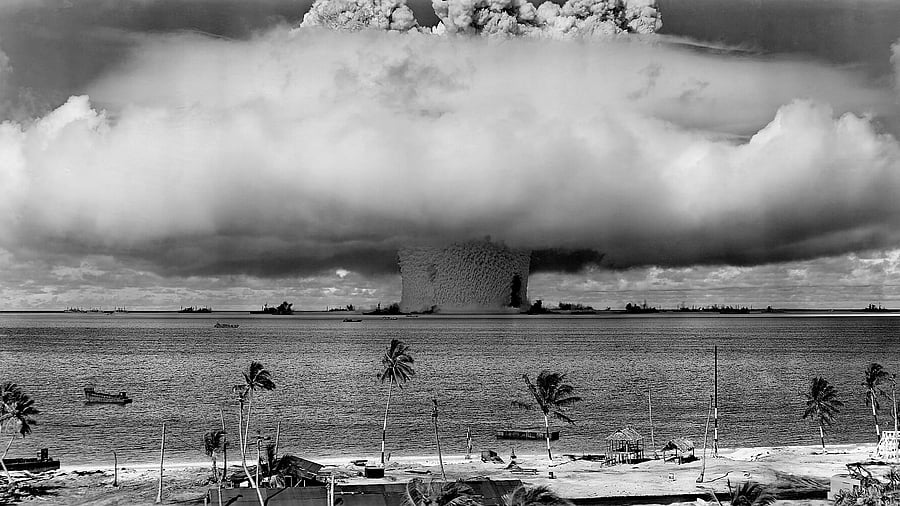
The 'Baker' explosion, part of Operation Crossroads, a nuclear weapon test by the United States military at Bikini Atoll, Micronesia, on July 25, 1946.
Credit: WIkimedia Commons/By Original: United States Department of Defense
The year 2025 marks 80 years since the advent of nuclear weaponry, beginning with the detonation of the first atomic test device—the so-called Trinity test—in New Mexico in 1945. In the current global climate, there is growing concern that more nations may pursue the development of nuclear weapons, particularly as a natural extension of uranium enrichment processes. Enriching uranium increases the concentration of the fissile isotope, making it more efficient for use in nuclear reactors. However, this same process also brings the enriched material closer to the levels required for nuclear detonation.
In addition to the potential spread of nuclear capabilities, apprehensions persist regarding the possible use of nuclear warheads by countries already known to possess them, especially amidst escalating tensions in certain regions, such as the subcontinent. These concerns take on added gravity when viewed in the context of eight decades of nuclear history—a history marked by devastating impacts, technological proliferation, and ongoing global insecurity.
The arms race and harm to environment
Eighty years ago, on August 6 and 9, 1945, the cities of Hiroshima and Nagasaki in Japan were devastated by the first wartime use of atomic bombs. These once vibrant urban centres were reduced to rubble in an instant, with hundreds of thousands of predominantly civilian inhabitants killed in a radioactive inferno. The fallout extended well beyond the immediate loss of life, inflicting genetic and toxic damage on subsequent generations.
Rather than serving as a sobering deterrent, these catastrophic events paradoxically inaugurated a global arms race, with nations vying to build increasingly powerful nuclear weapons. Hydrogen bombs—orders of magnitude more powerful than the Hiroshima bomb—were subsequently tested, with some Pacific islands rendered permanently uninhabitable. Atmospheric and underground testing in deserts led to significant radioactive fallout, impacting surrounding populations and ecosystems.
Over the following decades, thousands of nuclear weapons were tested, mainly by the so-called ‘Big Five’—the United States, Russia, China, France, and the United Kingdom—with the US and Russia dominating. The most powerful bomb ever tested, the Tsar Bomba, was detonated by Russia and yielded approximately 60 megatonnes, thousands of times more powerful than the Hiroshima bomb.
At the height of the Cold War, the combined nuclear arsenals of the superpowers approached 45,000 warheads, a quantity sufficient to destroy the planet multiple times. This period gave rise to the doctrine of Mutually Assured Destruction (MAD), under which the sheer scale of potential retaliation was seen as a deterrent against first strikes.
Technical foundations of enrichment
At the core of nuclear weapon development lies the process of uranium enrichment. The fissile isotope Uranium-235, which sustains a chain reaction, is found in natural uranium at a concentration of about 0.7%—roughly one part in 140. To be weaponisable, uranium must be enriched to significantly higher concentrations of U-235.
During the Manhattan Project and subsequent efforts, enrichment was primarily achieved via gaseous diffusion. In this method, uranium is converted to uranium hexafluoride gas, which then diffuses through membranes. As the U-235 isotope is slightly lighter, it diffuses more rapidly. Multiple stages of diffusion result in a gas sample increasingly enriched in U-235.
Later, more efficient techniques were developed using centrifuges. In this method, uranium hexafluoride gas is rotated at extremely high speeds. The lighter isotope is concentrated toward the centre and can be separated. When deployed in large numbers—thousands of centrifuges—this method can achieve high levels of enrichment, raising proliferation concerns. As a result, international efforts have been made to monitor and dismantle such facilities, often pre-emptively.
Even after multiple arms reduction treaties—such as START—led to the dismantling of thousands of warheads, an estimated 15,000 nuclear weapons still exist today. The vast majority remain in the hands of the US and Russia, with significant stockpiles also held by China, France, and the UK.
In recent years, global conflicts, such as the ongoing war in Ukraine, have rekindled fears of nuclear escalation. The UN Secretary-General has cautioned that a miscalculation or misunderstanding could lead to a catastrophe. Additionally, the vulnerability of large nuclear reactors in war zones poses a serious threat. The status of Ukraine’s former nuclear arsenal remains opaque, and the absence of a comprehensive global disarmament treaty with effective international oversight continues to hinder progress toward reducing nuclear risks.
A cosmic perspective
Amidst humanity’s persistent flirtation with self-annihilation through nuclear arms, the cosmic scale of destruction dwarfs our terrestrial capacities. For instance, a gamma-ray burst—potentially caused by the merger of neutron stars—located just 2,000 light-years away could deliver a lethal dose of radiation to Earth, surpassing the combined yield of every nuclear warhead on the planet.
Even more extreme, a Type Ia supernova—the thermonuclear explosion of a white dwarf—releases approximately 10²⁸ megatonnes of energy. This cosmic “C–O bomb” is a gravitational time bomb and produces an explosion a trillion trillion times more powerful than all human-made arsenals combined.
The 80th anniversary of nuclear weaponry is a moment not only for reflection but for renewed commitment to disarmament, oversight, and global cooperation. While technical advances in uranium enrichment continue, so does the risk of proliferation and accidental catastrophe. The lessons of Hiroshima and Nagasaki, the folly of the arms race, and the ongoing instability of global politics remind us that the nuclear threat remains very real.
(The author was a professor and a researcher)